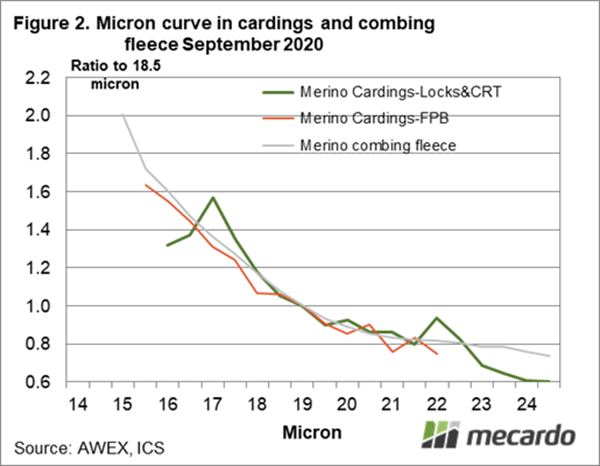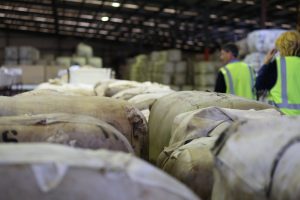Traditionally, fibre diameter is seen as of more importance to combing (longer) length wool. Micron premiums and discounts vary in response to changes in supply (as Mecardo often discusses) and demand. This article takes a look at the effect of fibre diameter on merino carding wool.
In cardings the key specifications tend to be length, colour, vegetable matter and bulk (a subjective term not captured by the reporting system). Cardings are a minor part of the greasy wool market in volume and value terms, with a single AWEX indicator (by region) devoted to them. This is the Merino Cardings indicator – an average of merino locks and crutching prices.
Micron premiums and discounts vary ‘Fine Wool Premiums…. Aug 2020’. A year ago fine merino micron premiums were very low. In Figure 1 the micron premium and discounts (with prices at 18.5 micron set to be the basis equalling 1) are shown for a combing fleece average, merino locks and crutchings and merino fleece, pieces and bellies with a staple length 50 mm and less in September 2019. The combing fleece micron curve is the standard measure of micron premiums and discounts, with the curve fairly flat from the broader end of merino microns to around 18 micron. Below 18 micron the micron premium picked up slowly but was low by historical standards.
The other two series in Figure 1 are carding series, with the locks and crutchings price flat from 15.5 micron and broader. The carding length fleece, pieces and bellies series was also flat, picking up slightly below 16 micron. Both cardings series micron curves were flatter for the finer micron categories than the combing fleece micron curve.
In the past year micron premiums for fine merino wool have picked up markedly. Figure 2 repeats the analysis of Figure1, but for September 2020 (the current market). A year ago 15 micron fleece wool was trading at 1.2 times the 18.5 micron price, whereas it is now trading at 2 times the 18.5 micron price. A year ago the 21 micron combing fleece price was trading at 0.94 of the 18.5 micron price, and now it is trading at 0.82 of the 18.5 micron price.
The rise in the combing merino fleece micron premiums has been large. Now look at the micron curves for the two carding series. They have followed the combing fleece effectively in lockstep. In the current market micron matters a lot to merino cardings prices. If you have a fine woolclip and are considering selling some of the bits and pieces including cardings privately and untested, think carefully about what price you should be aiming for.
What does it mean?
It would be interesting to know exactly why fine micron premiums for merino cardings have risen so much in a time of general weakness in the greasy wool market, and supply chain. It does mean that fine micron merino cardings should be sold tested where ever possible and mot mixed with broader wool.
Have any questions or comments?
Key Points
- Merino carding prices have followed the lead of combing prices in the past year, developing a steep micron premium and discount.
- This means fine micron merino cardings are considerably more valuable than medium and broad merino cardings.
- Care is required if selling some of this wool untested.
Click on graph to expand
Click on graph to expand
Data sources: AWEX, ICS, Mecardo













